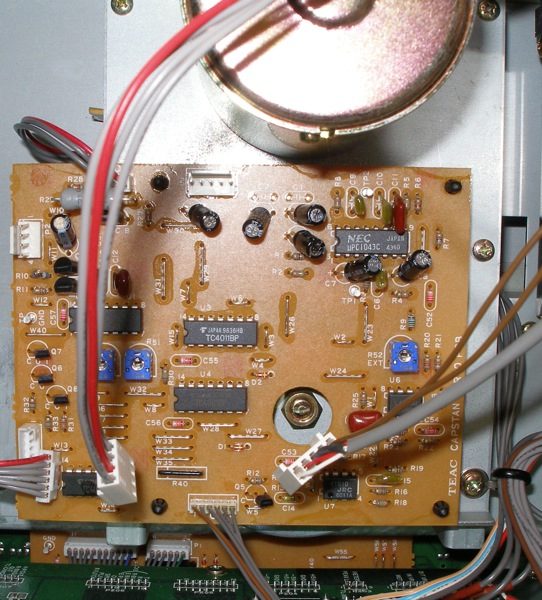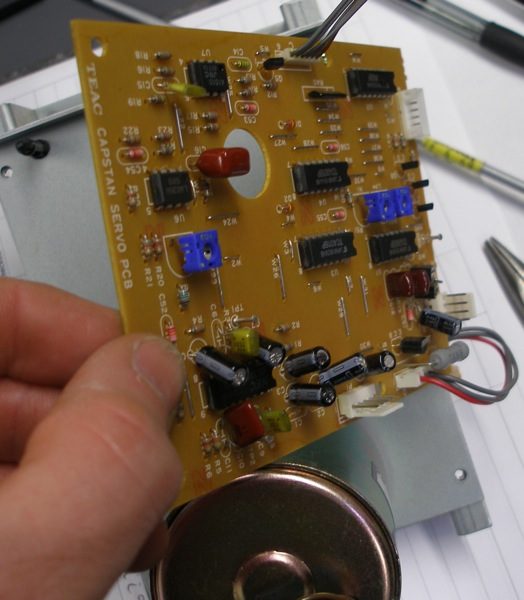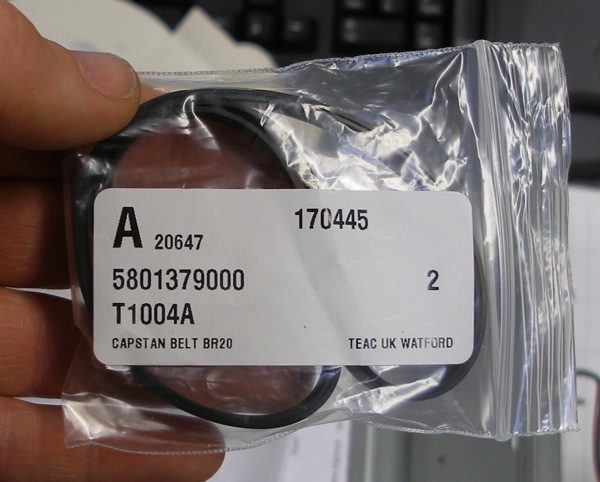Unseen to 32 years, although there could possibly be other tapes in the vaults at Abbey Road.
This NTSC U-matic transfer to uncompressed quicktime files was a damaged tape that at some point in its life had been ‘eaten’ by a greedy U-matic machine! The tape shell also had some plastic debris inside that needed removing before it was safe to attempt loading and migration.
greatbear
reel to reel tape transfer of rim drive or capstan free recordings
The capstan drive tape recorder is (or was) very common and was used in a huge range of cassette tape audio, video and open reel machines from cheap domestic to very expensive broadcast tape machines.
Occasionally we receive quarter inch tapes, always on small 3 inch spools, that reproduce on our capstan drive machines with terrible speed variation. They start off very fast then gradually slow down over the duration of the recording to around normal speed.
These reels must have been recorded on rim drive machines. These type of open reel tape recorders didn’t use a capstan and pinch roller to save space and more often cost. As there is no capstan, as the supply reel gets smaller the tape recording speed increases. When replayed on a rim drive machine the speed, while not likely to be ‘Studer stable’ will be pretty stable and the recording sound OK.
It’s not feasible or desirable for us to own unlimited machines of all types due to the time to service and repair them, find parts and storage space therefore we use a small range of carefully picked high quality tape machines that with care can replay most tapes, speeds and track formats. This is the problem with rim drive recordings and an analogue or digital solution must be found.
The tapes we received were 15 reels of family recordings from the Welsh Valleys. Others apparently had tried to transfer these tapes but gave up finding no material. This was easily solved as the tapes were wound the opposite way to normal so the oxide was facing out not in. This is the same as in audio cassettes. The original tape machine must have had its heads in a similar position to a cassette machine.
Major audio and video archive tape transfer and H264, MP4 video encoding for Archive for Mathematical Sciences and Philosophy
We’re very happy to be working with Mike Wright and the Archive for Mathematical Sciences and Philosophy on a large scale and ongoing transfer, restoration and online management programme.
Video time base corrector self destructing mains socket

We have several time base correctors and frame synchronisers at our disposal. One recent addition is a new old stock (NOS) CEL Tetra. This is an early 1990s motion adaptive Standards Converter for PAL, SECAM, NTSC 3.58 and NTSC 4.43 systems. A very flexible unit with composite, Y/C (S-Video), U-matic DUB High Band/Low Band and component inputs and outputs.
Out unit still has its shipping caps over the BNC sockets and looks unused but after 5 minutes of power a cloud of white smoke billowed out of the cooling fan accompanied by a pungent smell. The Shaffner EMI mains filter had a nasty, sticky brown residue leaking out and all around the back of it. This is the second TBC that I’ve had this happen to. I’d assumed these units get left on for long periods when used in broadcast applications which would hasten their demise. According to their website, the mean time between failures (MTBF) of their recent products is around 2,000,000 hours! Our CEL TBC doesn’t look like it’s done more than 30 minutes so maybe there’s been some dodgy electrolytic fluid in these units just like the motherboard capacitor problems between 2000 and 2003.
tape repair and restoration

We often receive enquiries about audio and video tape that is not in the best condition having been stored in humid conditions, suffering from binder hydrolysis (sticky shed) or not wound on its reel well, but we were surprised when we received this tape recently.
It literally is a bag of tape! It is a cassette tape that had at some point become unspooled, probably when the cassette shell was opened for a repair. We can and did restore the tape by respooling and reshelling before playing on one of our Nakamichi dual capstan cassette decks.
This is a time consuming job though as thin tape twists, turns and crinkles up very easily needing careful tension, customised winding systems and protection from contaminants such as dust, grease, etc that could cause more damage to an already compromised recording.
Switch mode power supply (SMPSU) repair in For-a FA-310P time base corrector
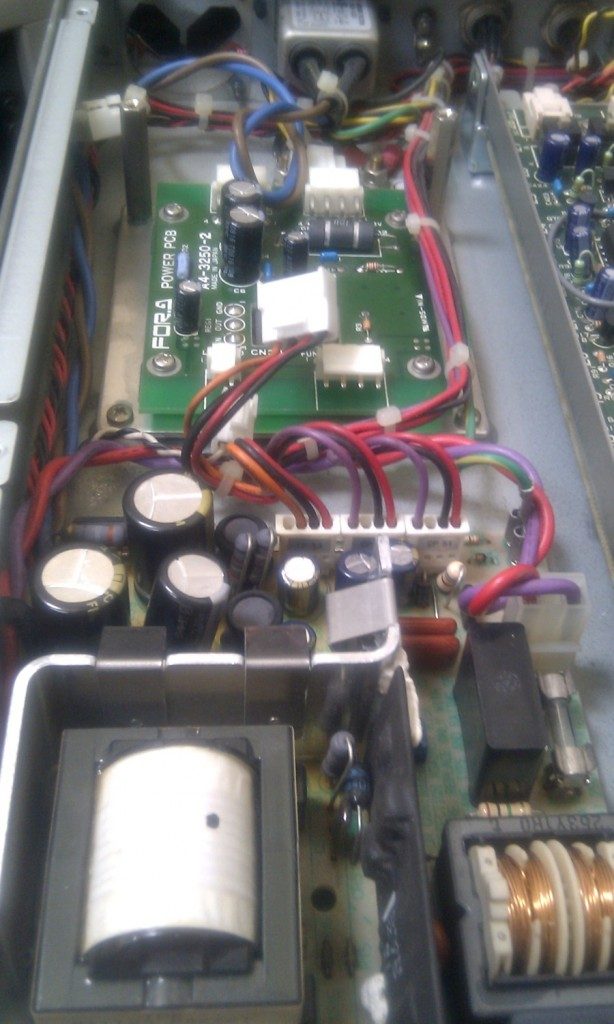
We use time base correctors and frame synchronizers all the time in the transfer and digitising of analogue video tape.
One of our more flexible and high quality units had recently developed an annoying and very obvious fault on its video outputs. While the unit was working there were faint but distinct horizontal lines on the video. This phenomenon is often called a hum bar and can be caused by ground loops.
In this case we isolated the unit from the rest of our installation and using a separate power point the problem was still there. Looking at the unit itself it is a very deep and heavy 1U case with two 40mm cooling fans at the rear corners. It is quite old too and being designed for continuous studio use is likely to get hot and have been on for very long periods.
The video fault appeared to be AC ripple ‘riding’ on the DC power. It was time to look at the electrolytic capacitors in the power supply.
Although I could have tested each one, all these caps were old and only rated for 3000 hrs at 85 celcius so they all had to go! Here’s a list of them:
The only one hard to find was the large 400v dump one. Most units now are thinner and taller but eBay came to rescue here.
This shotgun approach worked beautifully and the fault had gone. While tracing the exact fault is always the best way, capacitor often get a hard life and will not last indefinitely, especially in switch mode power supplies.
Audio data recovery from external USB drive using ddrescue
High resolution audio and video digital tape conversions can use large amounts of computer storage. 8 bit uncompressed Standard Definition (SD) PAL video runs at 70 GB per hour and 24 bit 96 kHz audio files at 2 GB per hour.
As a result of this many of our analogue to digital tape transfers require the use of external storage, usually USB 2.0 portable hard drives, to supply the copied digital transfers back to the customer. Some drives supplied by customers have not been of great quality and not designed to be sent about in the post. One such drive we had recently, a Sony Vaio branded 2.5″ USB drive wouldn’t copy certain directories of important files with the Mac OS Finder or the Windows Explorer. While most of the drive copied this certain folder always resulted in a crashed computer!
Thanks to GNU/Linux we have a bit more power and information at our disposal about hard drives and IDE or USB interfaces. It’s always best practice to copy as much information from the drive or mirror it before attempting any other types of data recovery or file system repair. Using the standard dd
Powerful tape conversion tools using SoX, LAME and Bash Scripting

One of our recent and ongoing jobs is a very large, over 2000, NAB 10.5 inch reel to reel archive of quarter inch professional tape recordings.
To fit into the budget but maintain quality we needed to find a way to streamline our workflow in converting the high resolution 24 bit 96 kHz master .wav files to CD quality (16 bit / 44.1 kHz) and MP3 (320 kbps) audio files.
Typically this would be done manually with 2 track audio software such as Audacity, Peak Audio Tools, Wavelab, etc with a Graphic User Interface (GUI). For such a large amount of individual files this is time consuming, expensive and unnecessary. While many audio editors have batch processing tools, Amadeus Pro being one of our favourites, they are still not as flexible as combining command line tools with a Bash script.
SoX is a powerful command line audio tool that can be used to edit, convert, process, record and play a wide range of digital audio files. It also has a very high quality resampling algorithm which we are using here.
Once the tape reels have been digitised they are split into individual .wav files which are then renamed with artist and track details using a php script that accesses a .csv file. These 24/96 resolution files are then converted to lower, CD resolution using SoX and to 320 kb/s MP3s using LAME. The script also uses sed, the stream editor, to add the text _16_44.wav or _mp3.mp3 to the filename for ease of identification. The script finds all files with the suffix _24_96.wav in all the subdirectories of it’s working directory and processes these.
At the moment this script is running under Mac OS X 10.5.8 using the MacPorts project but will, in time, be moved to one of our Apple G4 servers running the PowerPC version of Debian GNU/Linux 5.05 ‘Lenny’.
(Originally published on Jun 29, 2010)
Replace Tascam BR 20 Capstan Belt
We have two of these excellent machines in addition to our Sony APR 5003s and Studer A80s. The Tascam BR-20 was Tascam’s last and top of the range 1/4 inch reel to reel tape machine and available in two track stereo and stereo with centre timecode option.
The capstan drive in the BR20 is belt driven by a wide belt. Both belts in our machines looked OK but we’ve replaced all roller bearings, belts and pinch rollers in both of our machines anyway as a matter of course. These parts are still available from Teac UK via Acoustic Services on 01-844-347600.
Below is a simple explanation of how to change the capstan belt.

- Unplug machine from mains power and move to a strong stable base.
- Remove cross head screws from the rear panel and lift plate off. Depending on the type of plug in your country you may not be able to remove it completely.
- You’ll now be able to see the capstan motor and it’s control board attached to it.
- Remove the 4 cross head screws and gently lift the analogue audio output board away from the machine as in the picture above.
- We now need to remove the whole capstan motor assembly with the control board still attached. Remove the 4 cross head screws right at the front of the assembly, NOT the six nearest to you when looking at this image.
- Carefully unclip the 4 cable connectors from the motor control board. The other connector cannot be removed from the board and must be removed where it connects to the other board.
- The whole assembly can now be lifted out from the machine. Be careful to not snag any cables and remember to unclip the black cable ties.
- You’ll now be able to unclip the control board from the assembly by carefully compressing the black clips with some needle nose pliers.
- Now remove the six cross head screws holding the capstan motor assembly together. This is the only way to remove and refit the capstan belt. There’s not enough room to do it any other way!
- Now you can remove the old belt and capstan shaft. It’s a good idea to clean the capstan with IPA where the old belt has run and reapply a little grease to the bearing end of the capstan.
- Fit your new belt and reassembly is the reverse of dissasembly! Be careful though to not drop the screws into regions you can’t get them out of – luckily there aren’t that many on this machine but a long magnetic screwdriver is very useful.. just don’t get it anywhere near the headblock and heads!
Tascam BR 20 reel to reel new in box (not for sale)
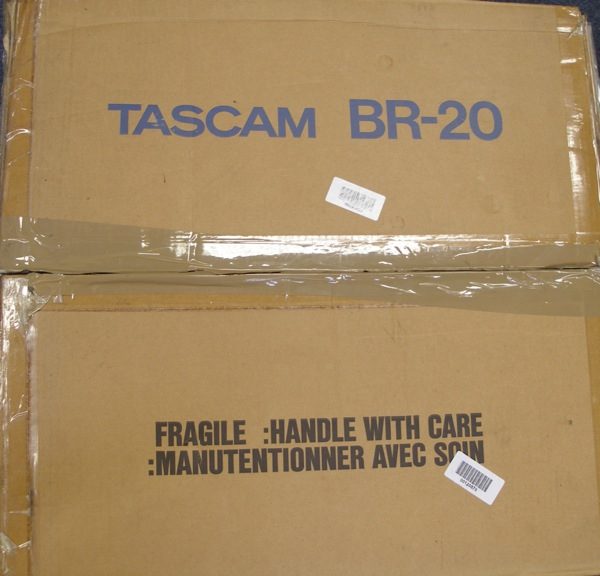
This is something you don’t see everyday! An almost unused and boxed 1/4″ 2 track reel to reel tape machine, a Tascam BR20 one of their highest quality machines sometimes installed with a Timecode head for broadcast and editing applications.
This machine somehow turned up at an IT Recycling centre in Essex but is now in much safer hands transferring tapes, in particular a very large archive of library music on 10.5″ NAB reels owned by Mood Media Ltd.
As you can see this machine is in its original box, with packaging and first look at the heads show almost no head wear but some nasty oxide that took a while to clean off.
This machine needed little work to bring it back to spec, a new capstan belt, pinch roller, tape tension and speed setting and a full calibration.
The capstan belt change is the subject of another blog post here..
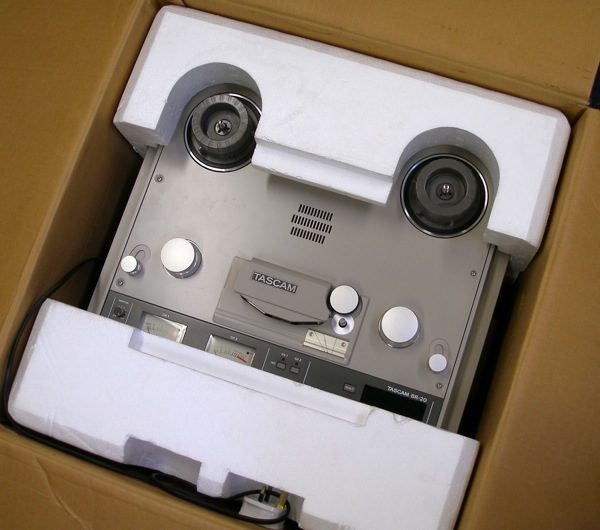
JVC PV-4800E 1/2 inch EIAJ colour portable video recorder
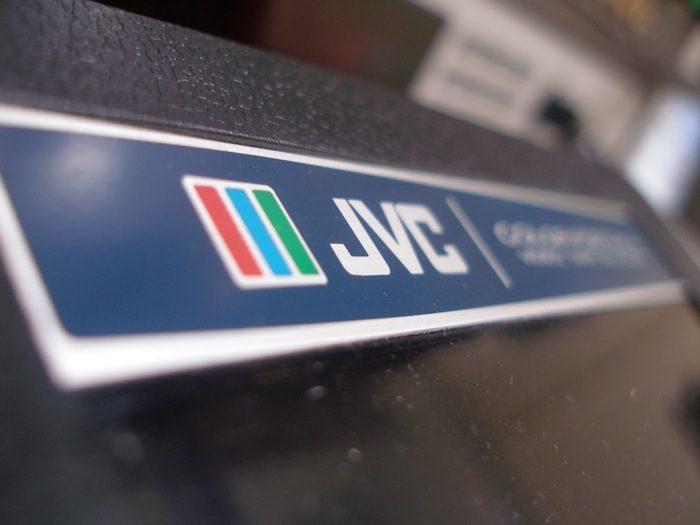
A recent addition to our video arsenal is this rare 1976 vintage 1/2″ colour reel to reel machine.
This has needed some work to get it functioning well such as new belts, hardened grease cleaned off the mechanism, etc but is now able to transfer colour recordings made in this format of reel to reel video.
A more detailed article on the repair of this will appear soon as will information about our other reel to reel video machines, the Hitachi / Shibaden EIAJ machine, the Sony CV-2100 skip field VTR and the enormous Ampex VPR-2B 1″ video machine… and we’ve got two of these!
Thanks to Rich at www.labguysworld.com for the JVC service manuals.
Information Terminals M-300, cassette tape transport alignment gauge
The regular service of analogue machines which will involve the mechanical alignment then electrical alignment / calibration is really important if you’re attempting to get optimum transfers and reduce any risk of damaging the potentially fragile tape.
While some of our machines are serviced by others we like to regularly check them and have gradually brought our regular servicing in house. Of course this needs specialised tools, test tapes and gauges, often totally unavailable new now.
On a lucky eBay day I happened to win one of these beauties, an Information Terminals M-300 gauge. This enables you to accurately set the tape guide height and also the head stroke. It is a universal gauge and can be used across many decks.

Nakamichi tape deck owners have had a hard time doing this part of their servicing as the original Nakamichi gauges are very very rare now as is this.
A member of the naktalk mailing list though recently borrowed our gauge and has had it measured and will soon have a small batch CNC machined and made available. These remanufactured gauges will have a few small modifications to improve the design.
Thanks to Willy at www.willyhermansnervices.com many more tape deck transports will be able to be aligned correctly.
U-matic transfer to DVD, Uncompressed Quicktime and Digi Beta
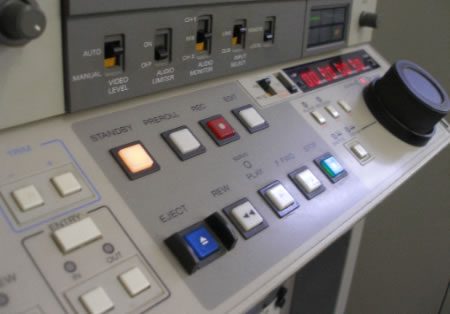
We’ve been honored recently to have won a large contract to help in the digital migration of an extensive educational video archive by the transfer from U-matic archive copies to uncompressed video files.
While the archive had been stored in an suitable environment and rarely if at all played, they had not survived well. The Sony branded tapes from the 1970s and 1980s all exhibited binder hydrolysis or sticky shed syndrome. We were still able to get good transfers though using our range of U-matic machines, particularly the Sony BVU-950P and For-A Time Base Corrector.
DVD video restoration / editing helps convict serial Bristol flytipper
Greatbear recently helped the Streetscene section of Bristol City Council in an investigation in a serial flytipper.
DVD footage of the flytipper had been taken by a member of the public of flytipping activity but this DVD had other unrelated footage on that needed removal. The DVD was also damaged and needed slow, repeated reading to rip the MPEG stream successfully.
Using MPEGstreamclip it was then straightforward to trim the stream, resave and create a new DVD with just the necessary footage.
See the BBC news article with the video, http://news.bbc.co.uk/1/hi/england/bristol/8029183.stm
Microcassette Transfer to CD helps Crown Court case

We’ve recently been involved, with Mobray Woodwards Solicitors, in the audio transfer of important evidence in a local Crown Court case.
Even given the poor quality or the recordings, made on the slowest tape speed of 1.2 cm/s we were able to make transfers to CD which were clear and understandable with CD track markings for easy access to specific sections of the audio.
Microcassettes, until recently, were used regularly for voice recording in small, portable dictaphone type of machines. Their fidelity is not high but when used for voice it is usually acceptable.
Greatbear are able to transfer all formats and speed of microcassette in addition to 1/2 speed standard cassettes that were common for voice recording of interviews and meetings in the police service, inquests, etc.
For more information on high quality audio tape transfer and restoration please visit our transfer pages.
Video Tape Transfer, Copy to DVD, DV or uncompressed AVI
Over the last 12 months we’ve seen this side of our business grow and adapt to the range of transfer needs that individuals, businesses and media creation organisations have.
We are able to support a wide range analogue and digital, consumer and professional video formats from the late 1970s onwards such as: Betamax, VHS, SVHS, VHS-C, Video 2000, 8mm, Hi8, U-matic, Betacam, miniDV, DVCAM, etc.
We offer straight video transfer to DVD and a higher quality transfer service to DV or uncompressed AVI which can then be supplied on hard drive, edited, encoded to a very high quality DVD or supplied on digital tape.
Update 2019!
We pride ourself on our positive, friendly service and are happy to give advice over the phone or by email. When you call us you won’t be stuck in a voicemail system or told we’re an internet company so don’t like speaking on the phone!
Feel free to contact us by phone or email.
Cassette tape, reel to reel and vinyl transfer support Bristol Archive Records
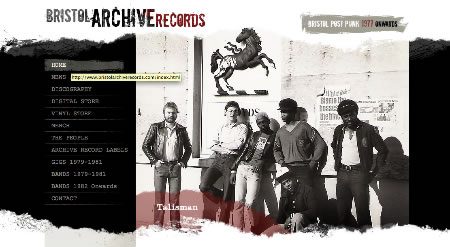
We’ve recently been proud to be regularly involved in the transfer of a range of rare and often unique recordings of great but often forgotten Bristol bands from the late 1970s onwards.
“… aims to showcase music from the diverse Bristol Music scene and provide a historical account / document of all things Bristol that should never be forgotten. Many of the artists and releases are rare, unknown or never before released. The material has been lovingly digitally remastered from vinyl, ¼ inch tape, dat or cassette. The original vinyl releases would generally have been limited to runs of 1000 copies or less.”
Many of the recordings have survived well over the years and sound great, a testament to the bands and the engineers that recorded them.
Listen to them here…
how not to pack a reel to reel machine
I use eBay alot. I have to, nobody makes new tape machines anymore and about two or three years ago it took over from the local freeads papers as a way to sell things you didn’t want.
I recently bought an old Teac X7 4 track 1/4″ reel to reel. Seemed like a good deal and I took a chance. With large heavy items I always ask politely if they can ensure it’s packed with lots of bubble wrap in preferably two boxes. I even offer to send the packaging myself if they haven’t budgeted for that or can’t be bothered to wrap that well!
This is what I received after a few days of waiting. The seller seemed excited, saying he’d specially bought a box that cost over £10…
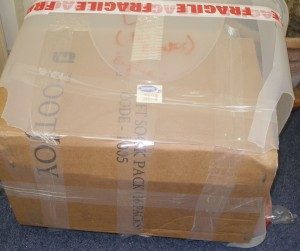
Reel to Reel packaging bottom
The whole of the bottom of the box had cracked and fallen away. If it hadn’t of been for the nice Parcelforce people who lined it with a bit of cardboard I wouldn’t have got anything.
There was a Teac X7 in it but it didn’t look pretty and is a perfect example of how heavy items can destroy themselves and the packaging if not packed correctly.
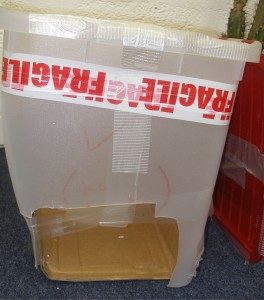
Reel to Reel packaging destroyed
reel to reel transfer

Studer A80 RC reel spinning
Over the last few years we’ve gradually built up our equipment inventory so we can now offer a wide range of audio and video transfers.
We’re very happy to offer all track formats and speeds of 1/4 inch reel to reel tape transfer, from mono / stereo tapes or multitrack recordings.
15 inches per second (ips) and 7.5 ips speeds are normally transferred on, our pride and joy, one of two Studer A80s. We also have a Tascam BR20 and several Revox A77s for backup. The slower speeds and 4 track mono stereo formats are catered for by Teac and Sony machines.
30 ips, 15, 7.5 and 3.75 can also be transferred on our Sony APR 5003.
We take pride in making sure these machines are calibrated and cleaned before each transfer.
Quite often we receive tape in poor condition, frequently a result of splicing tape ‘drying out’ as it’s a bit like sellotape and the splices breaking as the tape is played.
We are able to clean, resplice and repair tape before transfer.
Prices are competitive but not published here as we’ve found each job is different and needs certain attentions that need to be quoted for on an individual basis. We are happy though to offer an assess / listen service, as many customers don’t know what’s on their tapes and either don’t have a machine or their old machine is broken.
Recent work has included many valuable family history 5 inch reels. Remember tape is fragile, very susceptible to magnetic fields and doesn’t last forever. It’s worth transferring it or getting it transferred now to keep your memories safe.
You can see a more comprehensive list of all our audio equipment in our studio here:
http://thegreatbear.co.uk/audio-tape-transfer/studio-equipment-audio/
Tascam 234 4 track cassette capstan belt replacement
I’ve had these belts sitting around for a few months now and they’ve finally come around on my to do list. Thinking this would be nice and easy like the Teac C-3x belts I whipped the cover off my 234 eager to put it back to work transferring those thousands of undiscovered bedroom gems that must be around in peoples’ cupboards.
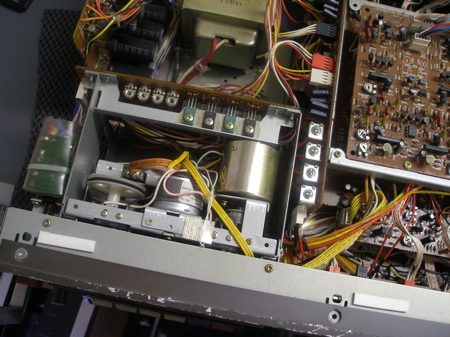
Tascam 234 4 track tape transport
Looked nicely laid out and well constructed as all this old Tascam equipment seems to be. I thought I’d just take the transport out and it’d be easy. There are just two belts in the 234, the capstan belt and the belt that moves the transport up and down. This cam mode belt had stretched and come off and the capstan belt had pretty much disintegrated. Once I start I find it hard to stop and this isn’t a quick job the first time, you need to be methodical and patient, good screwdrivers help too.
Well here comes the process, it seems pretty daunting at first when you see how many boards, cables and bits you have to remove and disassemble to replace the belts.
Continue reading →
Teac C-3x capstan belt
I recently ordered and replaced the capstan and counter belt on this cassette deck. These parts are easily available from Fred Marrs who sells a huge range of correctly sized replacement belts through his eBay shop. He has even gone to the lengths of remanufacturing the Nakamichi OC 8096 capstan belt to the correct specs.
This Teac machine is a really nice 3 head cassette deck, built like a tank, and very similar if not identical to the original Tascam 122. I don’t use this deck for normal cassette transfers as I feel my Nakamichi decks generally sound better but this is one of the few decks that can record and playback at double the normal speed so it’s reserved for these transfers and as a backup.
The transport is quick and easy to remove and the belt was easy once the capstan had been removed – this was also greased and oiled a little too.

Teac C-3x transport removed
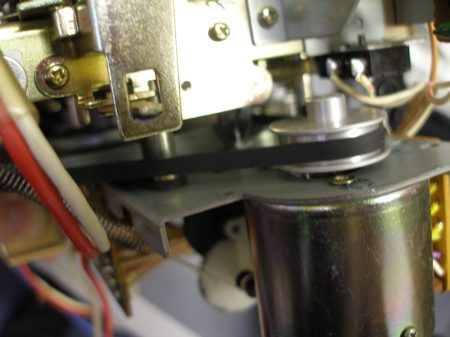
Teac C-3x capstan motor with new belt
Everything went well until I tested it with an old tape – It would play for a few seconds then the take up reel would stop letting tape get pulled around the pinch wheel, well and truly chewed! It looked like the rubber drive wheel that the reel motor works against has perished at one point or slips. I also noticed that the little rubber sleeves that act as brakes on the reels have perished too. I’m going to have to get it all apart again to fix this – see below for more soon..
Oh and here’s a the service manual for free, so you don’t have to get fleeced by an eBay seller who’s downloaded a load of free manuals.



